|
Advantech AIMB-215
Low-profile Intel Bay Trail-based Mini-ITX motherboard for industrial and embedded applications provides flexibility, power-efficient performance
(by Conrad H. Blickenstorfer)
When it comes to embedded systems development, designs and integrators have their choice of literally dozens of motherboard sizes and standards, and that's in addition to the (costly) option of creating proprietary custom boards. The picture below shows just some of the common board standards, and where the subject of this article — Advantech's AIMB-215 Mini-ITX — fits in:
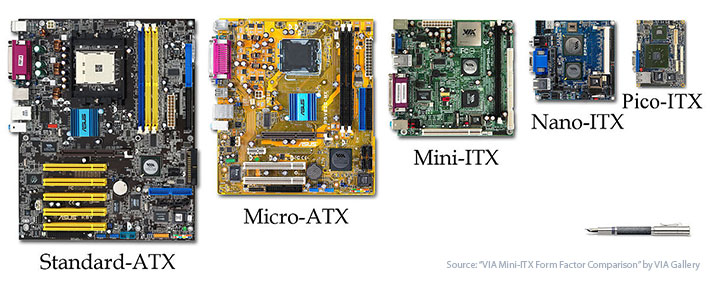
Why are there so many different embedded systems boards and board standards when all of them are, after all, just part of the circuitry sitting inside a box? That may be so, but to system integrators the choice of the exact right motherboard for a given project is a big issue. Here are some of the criteria for selecting a motherboard:
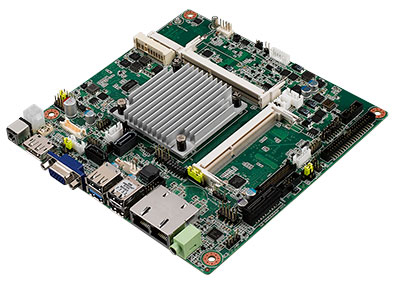
- Space considerations
- Available CPU and chipset technology
- Power requirements
- Interface requirements
- Standards support
- And, of course, cost
Further consider that of the about two dozen different computer board form factors to choose from not all are "full" motherboards. Some standards use Computer On Module (COM) technology where the processor and supporting technology are on a separate board — or "module" — that is then plugged into a "carrier" board designed for some specific purpose.
This way, system integrators can select the right COM for a complex embedded systems project and then concentrate on their application rather than having to design an entire computer from scratch, saving as much as 80% of the regular development time and cost.
Other times a project is best served by a fully integrated conventional motherboard, but there are very detailed requirements and space is an issue. In that case, the designer would look for a board with just the right functionality that also fits into the allotted space. For example, let's assume an application requires a good deal of computing power (but without breaking the bank), sufficient memory, support of multiple displays, multiple disks, dual high speed Ethernet ports, and as many USB ports and legacy serial ports as possible. Noise, heat generation and power consumption are all issues.
The system should be bootable from SATA or mSATA storage, and the board's footprint should be substantially smaller than a standard or micro ATX board, though due to the hefty onboard I/O requirements larger than some of the truly tiny standards. There should be PCI and mini-PCI expansion slots, but IDE and legacy PCI support isn't necessary. And, oh, there isn't much vertical space available, so the board must be under an inch tall. And that's exactly what Advantech created the AIMB-215 for.
The Advantech AIMB-215 Mini-ITX board
The Advantech AIMB-215 Mini-ITX board, introduced late 2014, is an industrial-grade thin Mini-ITX motherboard. The Mini-ITX form factor has been around since 2001 and specifies a 17 x 17 centimeter (6.7 x 6.7 inches) low-power board. Mini-ITX was originally conceived for entry-level platforms and industrial applications. Unlike some more exotic board types, Mini-ITX boards fit into generic computer cases and they use the generic PC case screw-mount patterns. Their small size and low power requirements, however, mean that they are perfect for custom applications where a standard PC needs to fit into a small space. And in this instance a space that's less than an inch tall (the AIMB-215 is just 21mm tall).

In the past, most Mini-ITX boards used very low power CPUs, such as Intel Atom chips, or similar designs from AMD or VIA. While those chips were able to deliver the precisely defined performance levels of many targeted applications,
often they just didn't have enough punch for more complex projects. The AIMB-215 addresses that issue by offering a trio of available Intel "Bay Trail" Celeron processors.
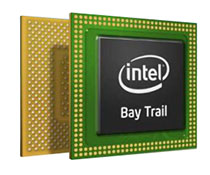 As far as Intel's "Bay Trail" processor platform goes, it's based on a heavily overhauled Atom processor architecture, but that's where the similarity to older Atoms ends. Bay Trail includes Atom, Celeron and even Pentium branded chips. That's a bit confusing as Intel traditionally used the Atom brand for its barest entry level processors, and the Celeron and Pentium brands as the low end of its Core processor lines. As far as Intel's "Bay Trail" processor platform goes, it's based on a heavily overhauled Atom processor architecture, but that's where the similarity to older Atoms ends. Bay Trail includes Atom, Celeron and even Pentium branded chips. That's a bit confusing as Intel traditionally used the Atom brand for its barest entry level processors, and the Celeron and Pentium brands as the low end of its Core processor lines.
A particular weakness in earlier Atom chips was their sluggish graphics performance. That's changed in Bay Trail, too, as the platform includes GPUs that use the same Intel execution units (EUs) as the HD 4000 graphics in Intel's 3rd generation "Ivy Bridge" Core processors. This gives them support for most of the same APIs and features — DirectX 11, OpenGL 3.X, and OpenCL 1.2 are all present on the API side, as is dual-display support.
|
Available CPUs (see full specs)
|
Intel Celeron
|
Intel Celeron
|
Intel Celeron
|
|
Model
|
J1900
|
N2930
|
N2807
|
|
Lithography
|
22nm
|
22nm
|
22nm
|
|
Cores/Threads
|
4/4
|
4/4
|
2/2
|
|
Base Clock Speed
|
2.00 GHz
|
1.83 GHz
|
1.58 GHz
|
|
Burst Frequency
|
2.42 GHz
|
2.16 GHz
|
2.16 GHz
|
|
Thermal Design Power (TDP)
|
10 watts
|
7.5 watts
|
4.3 watts
|
|
L2 Cache
|
2MB
|
2MB
|
1MB
|
|
Integrated graphics
|
HD Graphics (6 EUs)
|
HD Graphics (6 EUs)
|
HD Graphics (6 EUs)
|
|
Graphics base speed
|
688 MHz
|
313 MHz
|
313 MHz
|
|
Graphics max speed
|
854 MHz
|
854 MHz
|
750 MHz
|
|
Intel Wireless Display
|
No
|
Yes
|
Yes
|
The three processors available for the AIMB-215 are the Intel Celeron J1900, N2930, and N2807. Sometimes there is a very substantial difference between available processor options, but here things aren't so clear.
The dual-core Celeron N2807 is clearly the low end, and is the choice for projects where the lowest possible heat dissipation matters, and performance requirements will not exceed what the chip can offer.
The difference between the J1900 and the N2930 is more difficult to assess. Both are quad-core designs, but whereas the J1900 is part of Intel's Bay Trail-D low-end desktop chip lineup, the N2930 is classified as a Bay Trail-M chip for mobile duty. The J1900 runs a little faster both in CPU and GPU clock speed, which results in a higher thermal design power of 10 vs. 7.5 watts, and in some projects that can make a difference. One difference shown in Intel's spec sheets (which aren't always comprehensive) is that the N2930 supports Intel WiDi (Wireless Display) whereas the J1900 does not. WiDi permits wireless streaming of audio and video data to flatscreens.
Advantech considers this mini-ITX board as offering significant CPU and graphics performance improvements over their earlier mini-ITX offerings, such as the AIMB-210 or AIMB-213. Between the higher performance and the very low board profile, the AIMB-215 is clearly a prime candidate for numerous space-constrained applications such as panel PCs and digital signage boxes in ATMs, kiosks, point-of-sale systems, gaming, automation and similar.
Dual displays are supported via standard rear I/O VGA and DisplayPort connectors, as well as an internal LVDS connector on the board itself. If display resolution matters, note that the maximum resolutions vary between output method (see specs).
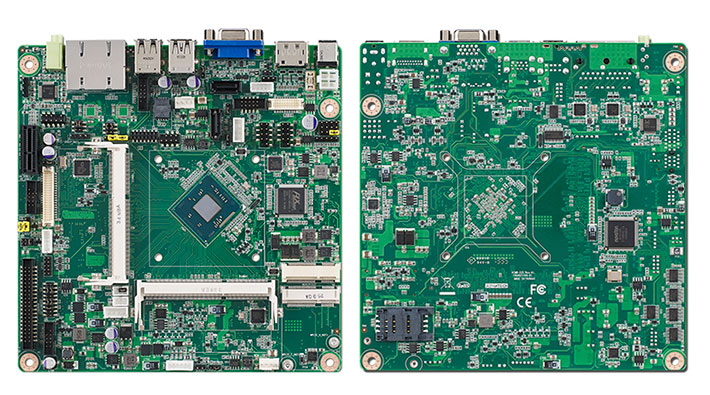
There is a single PCIe expansion slot, and also two mini-PCIe slots. RAM is provided via two 204-pin Non-ECC SODIMM slots that accommodates up to 16GB of DDR3L 1333 SDRAM.
The AIMB-215 board supports dual 10/100/1000Base-T gigabit Ethernet channels, and there are two RJ45 jacks on the rear I/O panel, both using Realtek 8111E controllers.
For storage, the AIMB-215 offers two onboard SATA connectors with a data transmission rate of up to 300 MB. There's also mSATA support via mini-PCIe (which has a SIM card holder on the bottom side of the board), but mSATA is only available when the SATA2 port is not in use. Unlike an earlier AIMB-213 board we reviewed, the AIMB-215 doesn't have a Compact Flash slot for the system to boot off.
The rear I/O panel has three USB 2.0 ports, a USB 3.0 port, VGA, DisplayPort, and audio. What you see on the rear I/O panel, however, is only part of what the AIMB-215 offers. On the board itself are six RS232 serial lines, six more USB 2.0 connector pins, LVDS, as well as an 8-bit Digital I/O (DIO) connector, and even PS/2 keyboard and mouse connectors. Also note the notebook-style power jack in addition to the 4-pin internal ATX connector. It's there because the AIMB-215 offers DC12V support.
Anyone who has ever built their own PC from parts knows about the system panel connector that interacts with buttons and lights on the case or enclosure. It links to the system power LED, reset button, power button, and hard disk activity light. That's no different on a Mini-ITX board.
The BIOS offers the usual wealth of setup options, both the common sense stuff and the arcane settings that sometimes make all the difference between an optimized system and one that tends to act up.

What's in the box?
Here is what Advantech ships when you buy the AIMB-215 for your project:
- AIMB-215 Mini-ITX motherboard
- Fanless CPU heatsink
- CD with user manual and all drivers
- 2 x 1-to-1 serial cables
- 1 x 1-to-4 serial cable
- 1 x SATA HDD cable
- 1 x SATA power cable
- I/O port bracket
- All screws needed for mounting the AIMB-215
Optionally available are various length USB cables, a keyboard/mouse cable, and power adapters. And there's a special extended temperature range version of a Celeron J1900-equipped AIMB-215.
Why pick the AIMB-215 Mini-ITX SBC?
Who should be interested in the AIMB-215? In short, anyone building industrial systems that have enhanced performance and substantial I/O requirements, including strong legacy support, yet must also run quietly and economically. The AIMB-215 meets those requirements here as it offers more connectivity than many full-size boards, and fanless operation doesn't only mean no noise, but also no electric fan that can fail. Bay Trail-based systems also cost a lot less than Intel Core-based solutions, so if mid-range performance at a low price point is an issue, this board definitely is an excellent candidate.
Of interest to systems integrators: The AIMB-215 supports Advantech's highly regarded SUSAccess and a number of embedded software APIs, including H/W Monitor, Brightness, Watchdog, GPIO) and utilities (BIOS Flash, Monitoring) that can can substantial functionality as well as reduce implementation time.
Below is a schematic of the Advantech AIMB-215:
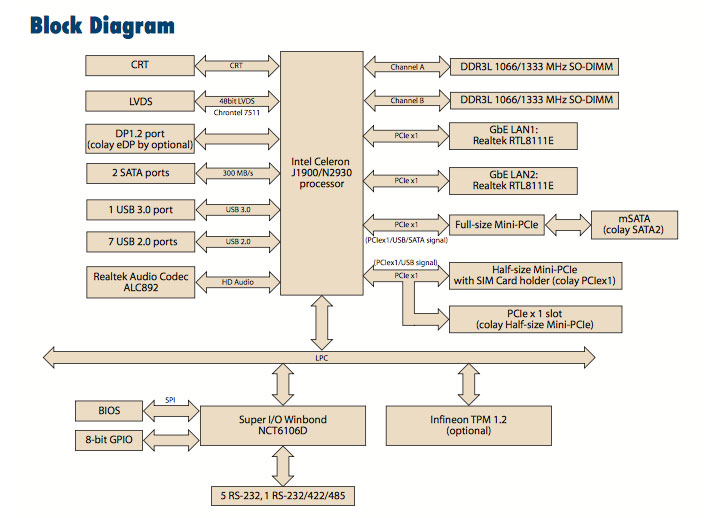
Mini-ITX has come a long way since the early days of the standard. While the Advantech AIMB-215 retains the original ITX spirit of a simple, flexible, power-efficient board for a variety of embedded and/or industrial applications where small size and efficiency matter, and it does so with Bay Trail's excellent power management capabilities and enhanced performance that is significantly above the levels of prior Intel Atom generations.
Advantech AIMB-215 Specs:
| Type |
Mini-ITX Motherboard
|
| CPU Type |
Intel Celeron J1900 (quad-core, 2MB L2 cache)
Intel Celeron N2930 (quad-core, 2MB L2 cache)
Intel Celeron N2807 (dual-core, 1MB L2 cache)
|
| Clock Speed |
Intel Celeron J1900: 2.00GHz (2.42GHz burst frequency)
Intel Celeron N2930: 1.83GHz (2.16GHz burst frequency)
Intel Celeron N2807: 1.58GHz (2.16GHz burst frequency)
|
| Thermal Design Power |
Intel Celeron J1900: 10 watts
Intel Celeron N2930: 7.5 watts
Intel Celeron N2807: 4.3 watts
|
| BIOS |
Award 16 Mbit, SPI
|
| OS |
Windows Embedded 7, Windows Embedded 8.x
|
| Memory |
Max 16GB DDR3L 1333MHz in two 204-pin SODIMM sockets |
| Graphics Controller |
Intel HD Graphics |
| VRAM |
Dynamically shared system memory up to 224 MB SDRAM |
| LVDS |
Supports dual channel 48-bit up to 1920 x 1200
|
| DisplayPort |
Supports DP++, resolution up to 2560 x 1600 colay eDP port (optional
|
| VGA |
Supports up to 2560 x 1600
|
| Dual display |
VGA + DP1.2, VGA + LVDS, LVDS + DP1.2, VGA + eDP (optional), LVDS + eDP (optional), supports extended mode and clone mode
|
| Watchdog Timer |
Performs system reset at programmable 1-255sec/min
|
| LAN |
2 x 10/100/1000Base-T (Realtek 8111E) |
| SATA |
2 x 300 MB/s, 1 x mSATA |
| IDE |
none
|
| Expansion |
1 x PCIe and 2 x Mini-PCIe
|
| USB |
7 x USB 2.0 (4 x rear panel, 3 x on board), 1 x USB 3.0 |
| Serial |
6 x RS232 (5 x RS232, 1 x RS232/422/485) |
| Parallel |
none |
| Audio |
3 (Mic-in, Line-out, Line-in) |
| DIO |
8-bit GPIO |
| Size |
170 mm x 170 mm (6.69" x 6.69"), only 21mm tall
|
| Weight |
13 ounces |
| Operating Temp. |
32° to 140°F (0° to 60°C); special -4° to 158°F (-20° to 70°C) version available |
| Price |
Mid US$200s |
| Datasheet |
Advantech AIMB-215 spec sheet |
| Manual |
Advantech AIMB-215 Manual |
Advantech Corporation
13 Whatney
Irvine, CA 92618
Toll Free: 1-800-866-6008
Ph: 949-420-2500
Fax: 949-420-2501
ECGInfo@advantech.com
www.advantech.com
Advantech Co. Ltd.
No.1, Alley 20, Lane 26, Rueiguang Road
Neihu District, Taipei Taiwan 114, R.O.C.
Tel: 886-2-2792-7818
Fax: 886-2-2794-7301
www.advantech.com
|








 As far as Intel's "Bay Trail" processor platform goes, it's based on a heavily overhauled Atom processor architecture, but that's where the similarity to older Atoms ends. Bay Trail includes Atom, Celeron and even Pentium branded chips. That's a bit confusing as Intel traditionally used the Atom brand for its barest entry level processors, and the Celeron and Pentium brands as the low end of its Core processor lines.
As far as Intel's "Bay Trail" processor platform goes, it's based on a heavily overhauled Atom processor architecture, but that's where the similarity to older Atoms ends. Bay Trail includes Atom, Celeron and even Pentium branded chips. That's a bit confusing as Intel traditionally used the Atom brand for its barest entry level processors, and the Celeron and Pentium brands as the low end of its Core processor lines.

